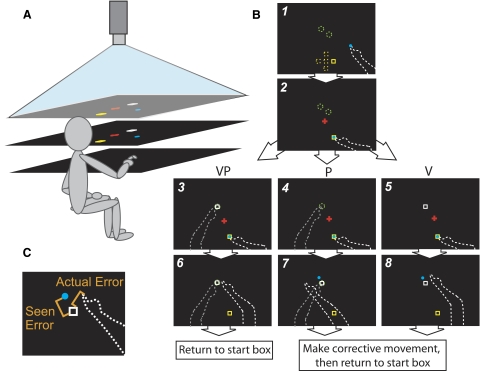Fig. 1.
Experimental setup. A: subject looks down into a horizontal mirror at chin level (middle) and sees images reflected from a horizontal rear projection screen (top). The reaching hand rests on a hard acrylic reaching surface (bottom) 22.5 cm below the mirror. The target hand remains below the reaching surface at all times. The mirror is positioned midway between screen and reaching surface, such that objects in the mirror appear to be in the plane of the reaching surface. Not pictured: black drapes obscuring the subject's vision of his arms and the room outside the apparatus. B: timeline of a single reach and bird's eye view of the display. Solid images were visible to the subject; dashed lines were not. The entire display was scaled to 80% of the subject's maximum reach, for a reaching distance of 13–33 cm. Subjects were physically able to point ≥15 cm past the farther target. Figure not to scale. Screen 1: subjects placed their reaching finger (white dashed line) in the yellow start box, which appeared in 1 of 5 possible positions (yellow dashed squares), with the aid of an 8 mm-diam blue cursor indicating reaching finger position (veridical to minimize proprioceptive drift between reaches: Wann and Ibrahim 1992). Possible start box positions were at origin (∼200 mm in front of subject's chest at midline; 1), 20 mm ahead of origin (2), 20 mm behind origin (3), 20 mm left of origin (4), or 20 mm right of origin (5). Screen 2: a red fixation cross appeared, and subjects were instructed to fixate on it for the duration of the reach. Screens 3–5: subjects positioned their target finger (dashed gray line) as instructed: on 1 of the 2 tactile markers stuck to the bottom of the reaching surface ∼40 mm apart (green dashed circles) for a proprioceptive (P) or visual-proprioceptive (VP) target, or down in their lap for a V target, which appeared as a 12 × 12-mm white box in 1 of the 2 possible target locations. On VP reaches, the V target was projected in the same location as the P target. For a subject of about average arm length, target position 1 was 18 mm right of origin and 118 mm ahead of origin. Target position 2 was 18 mm left of origin and 155 mm ahead of origin. Once both hands were correctly positioned, subjects reached toward the target with the cursor disappearing at movement initiation. Movement speed was not restricted, and subjects were permitted to make adjustments. Screens 6–8: when the reaching finger had not moved >2 mm for 2 s, the red fixation cross disappeared and the endpoint visual feedback (blue dot, P and V reaches only) appeared in a predetermined location unrelated to the reaching finger's true endpoint position. On P reaches, a 12 × 12-mm white box also appeared directly over the target finger position so subjects could see the error. If feedback indicated a miss, subjects had to make a corrective movement such that the blue feedback dot reached the center of the target. We included this step because of evidence that visual feedback while a hand is moving is a richer signal than static feedback from a stationary hand (Cheng and Sabes 2007); we also found that subjects were less likely to believe static feedback was veridical. If endpoint visual feedback was initially within 8 mm of the target's center, the target appeared to explode, indicating a hit, and no correction was required. C. close-up of screen 7 or 8 showing the 2 types of error information available to the subject at the end of a reach to a V or P target: “seen error” and “actual error.” Seen error (perceived visually) is the distance from the endpoint visual feedback (blue dot) to the target (white box); the blue dot's location is predetermined (held constant across subjects in a given condition) and so independent of the actual error (distance between reaching finger's final position and the target, estimated nonvisually through proprioception or efference copy).

